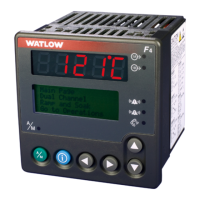Watlow Series F4P Appendix ■ A.7
process variable — The parameter that is con-
trolled or measured. Typical examples are tempera-
ture, relative humidity, pressure, flow, fluid level,
events, etc. The high process variable is the highest
value of the process range, expressed in engineer-
ing units. The low process variable is the lowest
value of the process range.
proportional — Output effort proportional to the
error from set point. For example, if the proportion-
al band is 20° and the process is 10° below set
point, the heat proportioned effort is 50 percent.
The lower the PB value, the higher the gain.
proportional band (PB) — A range in which the
proportioning function of the control is active. Ex-
pressed in units, degrees or percent of span. See
PID.
proportional control — A control using only the
P (proportional) value of PID control.
radio frequency interference (RFI) — Electro-
magnetic waves between the frequencies of 10 KHz
and 300 GHz that can affect susceptible systems by
conduction through sensor or power input lines,
and by radiation through space.
ramp — A programmed increase in the tempera-
ture of a set point system.
range — The area between two limits in which a
quantity or value is measured. It is usually de-
scribed in terms of lower and upper limits.
rate — Anticipatory action that is based on the
rate of temperature change, and compensates to
minimize overshoot and undershoot. See derivative.
rate band — A range in which the rate function of
a controller is active. Expressed in multiples of the
proportional band. See PID.
reference junction — see junction, reference.
reset — Control action that automatically elimi-
nates offset, or droop, between set point and actual
process temperature. Also see integral.
automatic reset — The integral function
of a PI or PID temperature controller that adjusts
the process temperature to the set point after the
system stabilizes. The inverse of integral.
automatic power reset — A feature in
latching limit controls that does not recognize pow-
er outage as a limit condition. When power is re-
stored, the output is re-energized automatically, as
long as the temperature is within limits.
resistance temperature detector (RTD) — A
sensor that uses the resistance temperature char-
acteristic to measure temperature. There are two
basic types of RTDs: the wire RTD, which is usual-
ly made of platinum, and the thermistor, which is
made of a semiconductor material. The wire RTD is
a positive temperature coefficient sensor only, while
the thermistor can have either a negative or posi-
tive temperature coefficient.
retransmit — An output that provides a scalable
analog signal that represents an input value, set
point value or output power level.
RFI — See radio frequency interference.
RTD — See resistance temperature detector.
serial communications — A method of transmit-
ting information between devices by sending all
bits serially over a single communication channel.
set point — The desired value programmed into a
controller. For example, the temperature at which a
system is to be maintained.
SI (Systeme Internationale) — The system of
standard metric units.
switching differential — See hysteresis.
thermal system — A regulated environment that
consists of a heat source, heat transfer medium or
load, sensing device and a control instrument.
thermocouple (t/c) — A temperature sensing de-
vice made by joining two dissimilar metals. This
junction produces an electrical voltage in propor-
tion to the difference in temperature between the
hot junction (sensing junction) and the lead wire
connection to the instrument (cold junction).
thermocouple break protection — The ability of
a control to detect a break in the thermocouple cir-
cuit and take a predetermined action.
time proportioning control — A method of con-
trolling power by varying the on/off duty cycle of an
output. This variance is proportional to the differ-
ence between the set point and the actual process
temperature.
transmitter — A device that transmits tempera-
ture data from either a thermocouple or a resis-
tance temperature detector (RTD) by way of a two-
wire loop. The loop has an external power supply.
The transmitter acts as a variable resistor with re-
spect to its input signal. Transmitters are desirable
when long lead or extension wires produce unac-
ceptable signal degradation.
WATLINK— A Windows-based software applica-
tion for configuring and communicating with Wat-
low controllers.
zero cross — Action that provides output switch-
ing only at or near the zero-voltage crossing points
of the ac sine wave. See burst fire.
zero switching — See zero cross.

